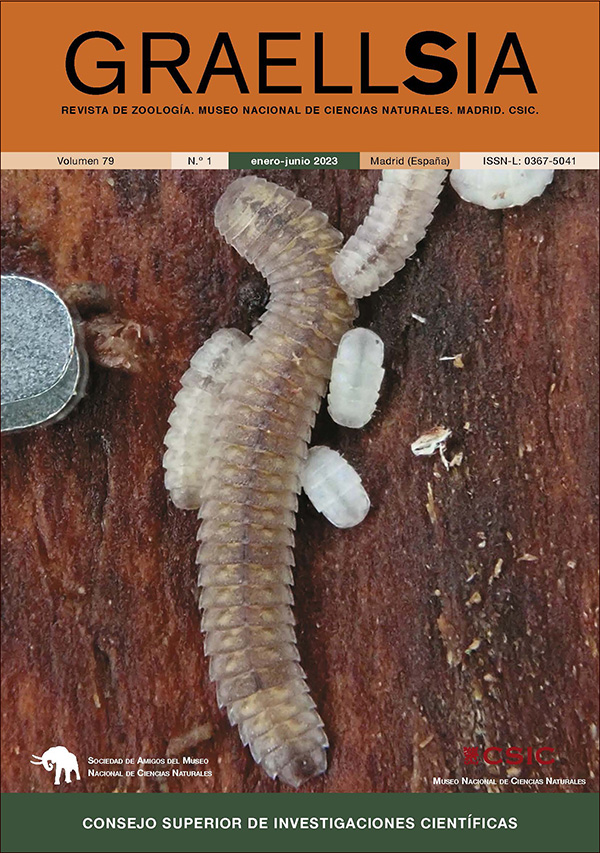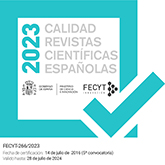Todo lo que puedas comer: depredación de vertebrados e invertebrados autóctonos por parte de la araña introducida Parasteatoda tepidariorum (C.L. Koch, 1837) (Araneae: Theridiidae) en dos hábitats antropogénicos de Italia
DOI:
https://doi.org/10.3989/graellsia.2023.v79.350Palabras clave:
Araneae, Theridiidae, Parasteatoda tepidariorum, Europa, Ecología, Depredación sobre vertebrados, Podarcis siculus, Alpiscorpius sigmaResumen
Reportamos las dos principales presas autóctonas de la araña introducida Parasteatoda tepidariorum (C.L. Koch, 1841) en dos hábitats antropogénicos de los Alpes italianos, específicamente una especie de lagartija y una especie de escorpión: Podarcis siculus (Rafinesque, 1810) y Alpiscorpius sigma Kovařík, Štundlová, Fet & Šťáhlavský, 2019. Además, describimos brevemente el comportamiento depredador de esta araña con ambas presas, destacamos la escasez de registros de depredación de invertebrados sobre vertebrados en Europa y comentamos posibles efectos negativos sobre las poblaciones autóctonas.
Descargas
Citas
Baudrot, V., Perasso, A., Fritsch, C, Giraudoux, P. & Raoul, F., 2016. The adaptation of generalist predators' diet in a multi-prey context: Insights from new functional responses. Ecology, 97: 1832-1841. https://doi.org/10.1890/15-0427.1 PMid:27859163
Blasco-Aróstegui, J., García-Gila, J. & Francke, O. F., 2020. Ecological aspects of the interactions between Centruroides limbatus and Tityus ocelote (Scorpiones: Buthidae) in a Caribbean Forest of Costa Rica. Revista Mexicana de Biodiversidad, 91: 1-14. e913418.
Bonnet, P., 1930. Les araignées exotiques en Europe. Annales de la Société Entomologique de France, 99: 49-64.
Brechtel, A., Gross, T. & Drossel, B., 2019. Far-ranging generalist top predators enhance the stability of meta-food webs. Scientific Reports, 9: 1-15. https://doi.org/10.1038/s41598-019-48731-y PMid:31439912 PMCid:PMC6706381
Brose, U., Williams, R. J. & Martinez, N. D., 2006. Allometric scaling enhances stability in complex food webs. Ecology Letters, 9: 1228-1236. https://doi.org/10.1111/j.1461-0248.2006.00978.x PMid:17040325
Chesson, P. L., 1984. Variable predators and switching behavior. Theoretical Population Biology, 26: 1-26. https://doi.org/10.1016/0040-5809(84)90021-2
Da Silva, A. A., Rohde, C. & De Lira, A. F. A., 2021. Record of mygalomorph spider (Araneae: Theraphosidae) predation by a scorpion (Scorpiones: Buthidae) in a Brazilian seasonally dry tropical forest. Arachnology, 18: 1068-1069. https://doi.org/10.13156/arac.2021.18.9.1068
Dickman, C. R., 1996. Impact of exotic generalist predators on the native fauna of Australia. Wildlife Biology, 2: 185-195. https://doi.org/10.2981/wlb.1996.018
Dobson, A., Lodge, D., Alder, J., Cumming, G. S., Keymer, J., McGlade, J., ... & Xenopoulos, M. A., 2006. Habitat loss, trophic collapse, and the decline of ecosystem services. Ecology, 87: 1915-1924. https://doi.org/10.1890/0012-9658(2006)87[1915:HLTCAT]2.0.CO;2 PMid:16937628
Duberstein, J. N. & Sherwood, D., 2020. Predation of Paravaejovis spinigerus (Wood, 1863) (Scopriones: Vaejovidae) by Aphonopelma chalcodes Chamerlin, 1940 (Araneae: Theraphosidae) in Arizona. Arachnology, 18: 496-498. https://doi.org/10.13156/arac.2020.18.5.496
Gendreau, K. L., Haney, R. A., Schwager, E. E., Wierschin, T., Stanke, M., Richards, S. & Garb, J. E., 2017. House spider genome uncovers evolutionary shifts in the diversity and expression of black widow venom proteins associated with extreme toxicity. BMC Genomics, 18: 178. https://doi.org/10.1186/s12864-017-3551-7 PMid:28209133 PMCid:PMC5314461
Glasser, J. W., 1979. The role of predation in shaping and maintaining the structure of communities. The American Naturalist, 113: 631-641. https://doi.org/10.1086/283422
Gross, T., Rudolf, L., Levin, S. A. & Dieckmann, U., 2009. Generalized models reveal stabilizing factors in food webs. Science, 325: 747-750. https://doi.org/10.1126/science.1173536 PMid:19661430
Hänggi, A. & Straub, S., 2016. Storage buildings and greenhouses as stepping stones for non-native potentially invasive spiders (Araneae)-a baseline study in Basel, Switzerland. Arachnologische Mitteilungen, 51: 1-8. https://doi.org/10.5431/aramit5101
Kovařík, F. Štundlová, J., Fet, V., & Šťáhlavský, F., 2019. Seven new Alpine species of the genus Alpiscorpius Gantenbein et al., 1999, stat. n. (Scorpiones: Euscorpiidae). Euscorpius, 287: 1-29. https://doi.org/10.18590/euscorpius.2019.vol2019.iss287.1
Levins, R. & Macarthur, R., 1969. An hypothesis to explain the incidence of monophagy. Ecology, 50: 910-911. https://doi.org/10.2307/1933709
May, R., 1972. Will a Large Complex System be Stable? Nature, 238: 413-414. https://doi.org/10.1038/238413a0 PMid:4559589
Mittmann, B. & Wolff, C., 2012. Embryonic development and staging of the cobweb spider Parasteatoda tepidariorum C.L. Koch, 1841 (syn.: Achaearanea tepidariorum; Araneomorphae; Theridiidae). Development Genes and Evolution, 222: 189-216. https://doi.org/10.1007/s00427-012-0401-0 PMid:22569930
Mora-Rubio, C. & Parejo-Pulido, D., 2021. Notas sobre la dieta de la viuda negra mediterránea Latrodectus tredecimguttatus (Rossi, 1790) (Araneae: Theridiidae) en el suroeste de la península ibérica. Graellsia, 77: e138. https://doi.org/10.3989/graellsia.2021.v77.297
Murdoch, W. W., 1969. Switching in general predators: experiments on predator specificity and stability of populations. Ecological Monographs, 39: 335-354. https://doi.org/10.2307/1942352
Nentwig, W., 2015. Introduction, establishment rate, pathways and impact of spiders alien to Europe. Biological Invasions, 17: 2757-2778. https://doi.org/10.1007/s10530-015-0912-5
Nentwig, W., Blick, T., Gloor, D., Hänggi, A. & Kropf, C., 2022. Spiders of Europe, online at https://araneae.nmbe.ch/, accessed on {21-02-2022}.
Nyffeler, M. & Pusey, B. J., 2014. Fish predation by semi-aquatic spiders: a global pattern. PLoS ONE, 9: e99459. https://doi.org/10.1371/journal.pone.0099459 PMid:24940885 PMCid:PMC4062410
O'Shea, M. & Kelly, K., 2017. Predation on a weasel skink (Saproscincus mustelinus) (Squamata: Scincidae: Lygosominae) by a redback spider (Latrodectus hasselti) (Araneae: Araneomorpha: Theridiidae), with a review of other Latrodectus predation events involving squamates. Herpetofauna, 44: 49-55.
Parsons, T., 1992. The removal of marine predators by fisheries and the impact of trophic structure. Marine Pollution Bulletin, 25: 51-53. https://doi.org/10.1016/0025-326X(92)90185-9
Pekár, S., Coddington, J. A. & Blackledge, T. A., 2012. Evolution of stenophagy in spiders (Araneae): Evidence based on the comparative analysis of spider diets. Evolution, 66: 776-806. https://doi.org/10.1111/j.1558-5646.2011.01471.x PMid:22380440
Polis, G. A., Myers, C. A. & Holt, R. D., 1989. The ecology and evolution of intraguild predation: potential competitors that eat each other. Annual Review of Ecology and Systematics, 20: 297-330. https://doi.org/10.1146/annurev.es.20.110189.001501
Pompozzi, G., Ferretti, N., Schwerdt, L., Copperi, S., Ferrero, A. A. & Simó, M., 2013. The diet of the black widow spider Latrodectus mirabilis (Theridiidae) in two cereal crops of central Argentina. Iheringia. Série Zoologia, 103: 388-392. https://doi.org/10.1590/S0073-47212013000400009
Root, R. B., 1967. The niche exploitation pattern of the blue-gray gnatcatcher. Ecological Monographs, 37: 317-350. https://doi.org/10.2307/1942327
Salomon, M., 2011. The natural diet of a polyphagous predator, Latrodectus hesperus (Araneae: Theridiidae), over one year. The Journal of Arachnology, 39: 154-160. https://doi.org/10.1636/P10-25.1
Schomburg, C., Turetzek, N., Schacht, M. I., Schneider, J., Kirfel, P., Prpic, N. M. & Posnien, N., 2015. Molecular characterization and embryonic origin of the eyes in the common house spider Parasteatoda tepidariorum. EvoDevo, 6: 1-14. https://doi.org/10.1186/s13227-015-0011-9 PMid:26034574 PMCid:PMC4450840
Speybroeck, J., Beukema, W., Bok, B. & Van der Voort, J., 2017. Guía de campo de los Anfibios y Reptiles de España y de Europa. Ediciones Omega, pp. 302.
Terborgh, J., Lopez, L., Nuñez, P., Rao, M., Shahabuddin, G., Orihuela, G., Riveros, M., Ascanio, R., Adler, G. H., Lambert, T. D. & Balbas, L., 2001. Ecological meltdown in predator-free forest fragments. Science, 294: 1923-1926. https://doi.org/10.1126/science.1064397 PMid:11729317
Valdez, J. W., 2020. Arthropods as vertebrate predators: A review of global patterns. Global Ecology and Biogeography, 29: 1691-1703. https://doi.org/10.1111/geb.13157
Vink, C. J., Derraik, J. G., Phillips, C. B. & Sirvid, P. J., 2011. The invasive Australian redback spider, Latrodectus hasseltii Thorell 1870 (Araneae: Theridiidae): current and potential distributions, and likely impacts. Biological Invasions, 13: 1003-1019. https://doi.org/10.1007/s10530-010-9885-6
Williams, J. L., Moya-Laraño, J. & Wise, D. H., 2006. Burrow decorations as antipredatory devices. Behavioral Ecology, 17: 586-590. https://doi.org/10.1093/beheco/ark003
World Spider Catalog, 2022. World Spider Catalog. Version 23.0. Natural History Museum Bern, online at http://wsc.nmbe.ch, accessed on {21-02-2022}.
Publicado
Cómo citar
Número
Sección
Licencia
Derechos de autor 2023 Consejo Superior de Investigaciones Científicas (CSIC)

Esta obra está bajo una licencia internacional Creative Commons Atribución 4.0.
© CSIC. Los originales publicados en las ediciones impresa y electrónica de esta Revista son propiedad del Consejo Superior de Investigaciones Científicas, siendo necesario citar la procedencia en cualquier reproducción parcial o total.Salvo indicación contraria, todos los contenidos de la edición electrónica se distribuyen bajo una licencia de uso y distribución “Creative Commons Reconocimiento 4.0 Internacional ” (CC BY 4.0). Puede consultar desde aquí la versión informativa y el texto legal de la licencia. Esta circunstancia ha de hacerse constar expresamente de esta forma cuando sea necesario.
No se autoriza el depósito en repositorios, páginas web personales o similares de cualquier otra versión distinta a la publicada por el editor.














